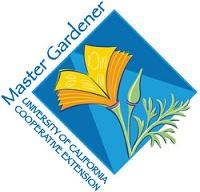
University of California
UC Master Gardener Program of Sonoma County
Persimmons
Of all fruit and ornamental trees, persimmons are one of the most brilliantly adorned in autumn. As vivid, eye-catching foliage in shades of red, orange, and yellow begins to fall, bountiful crops of delicious orange fruits are exposed on bare branches, ready for harvest.
Persimmon Attributes
- Eye-catching foliage, delicious fruit, little maintenance, heat and cold tolerance, and low-water needs add up to an attractive tree for gardeners in any Sonoma County microclimate.
- Small tree size, 15-30 ft. high and wide for many years, fits easily in fruit orchards or in many backyards.
- Unlike many deciduous fruit trees, persimmons need little winter chill to be productive.
- Persimmons are self-pollinating and do not require a second tree for fruiting.
- Late spring blossoms appear after leaves emerge and avoid frost damage.
- Fruit ripens in November well after most other homegrown fruits have come and gone.
- Mature fruits may be left on the tree and easily harvested over a period of weeks in late fall after leaves drop.
- Persimmons are relatively disease and pest free.
Kinds of Persimmons
- Native American persimmons are found along the east coast & across some southern states. They are highly astringent, very small, only 1-2 in. in diameter. They become soft and sweet, deep orange, often tinted blue, when ripe. They are usually harvested from wild trees.
- Hundreds of Japanese or Oriental cultivars are known but only a few are widely grown. Nurseries carry several with names similar to the popular ‘Hachiya’ and ‘Fuyu’. Most have fruits 3-4 inches in diameter.
- Highly astringent ‘Hachiya’ persimmons are heart- or acorn-shaped. They are a favorite for their soft texture and sweet taste but only when soft and fully ripe. Because birds are attracted, they are best picked when they achieve full color but are still firm, then brought indoors to finish ripening at room temperature. They may be seedless or have a few seeds.
- The ‘Fuyu’ cultivar produces a flattened, roundish, non-astringent fruit that is edible when firm or slightly softened. Fruits usually become fully orange or orange-red on the tree but may be picked a little early if birds or squirrels are attracted. Some have seeds.
- Dwarf forms of several Japanese varieties are available.
Growth and Care
- While persimmons are more tolerant of clay than many fruit trees, good drainage is critical.
- Japanese persimmons have a strong tap root and require a fairly deep planting hole in full sun.
- Bare root persimmons are available at most nurseries January-March. Click here for detailed information on planting: Bare-Root Fruit Trees.
- Prune a young persimmon to encourage an open vase growth habit, a pattern of strong main branches for support of large fruit crops.
- As the tree grows, prune out dead or crossing branches and any suckers below the graft line. The graft leaves a visible bud union where the scion and rootstock meet. Look for a small jog on the lower stem, often where the trunk joins the roots, sometimes higher on the stem.
- If crops are sparse, in subsequent years spread a balanced 10-10-10 fertilizer evenly over the ground in late winter or early spring as far as the canopy reaches; in the absence of rain, water it in. Too much nitrogen will cause fruit to drop. Healthy mature leaves are deep, glossy green.
- Persimmons are considered drought-resistant, but, when winter rains are sparse, irrigating every few weeks from late spring through summer increases fruit production.
- When using drip irrigation, take care to move emitters away from trunk towards the drip line as a tree grows.
- Use hand clippers to harvest fruit, cutting the stem close to the calyx.
Additional Information
- https://homeorchard.ucanr.edu/Fruits_&_Nuts/Persimmon/
- https://sonomamg.ucanr.edu/The_Kitchen_Garden/Additional_KG_Articles/Planting_Bare-root_Fruit_Trees/
- https://homeorchard.ucanr.edu/The_Big_Picture/Pruning_&_Training/
February 2022






